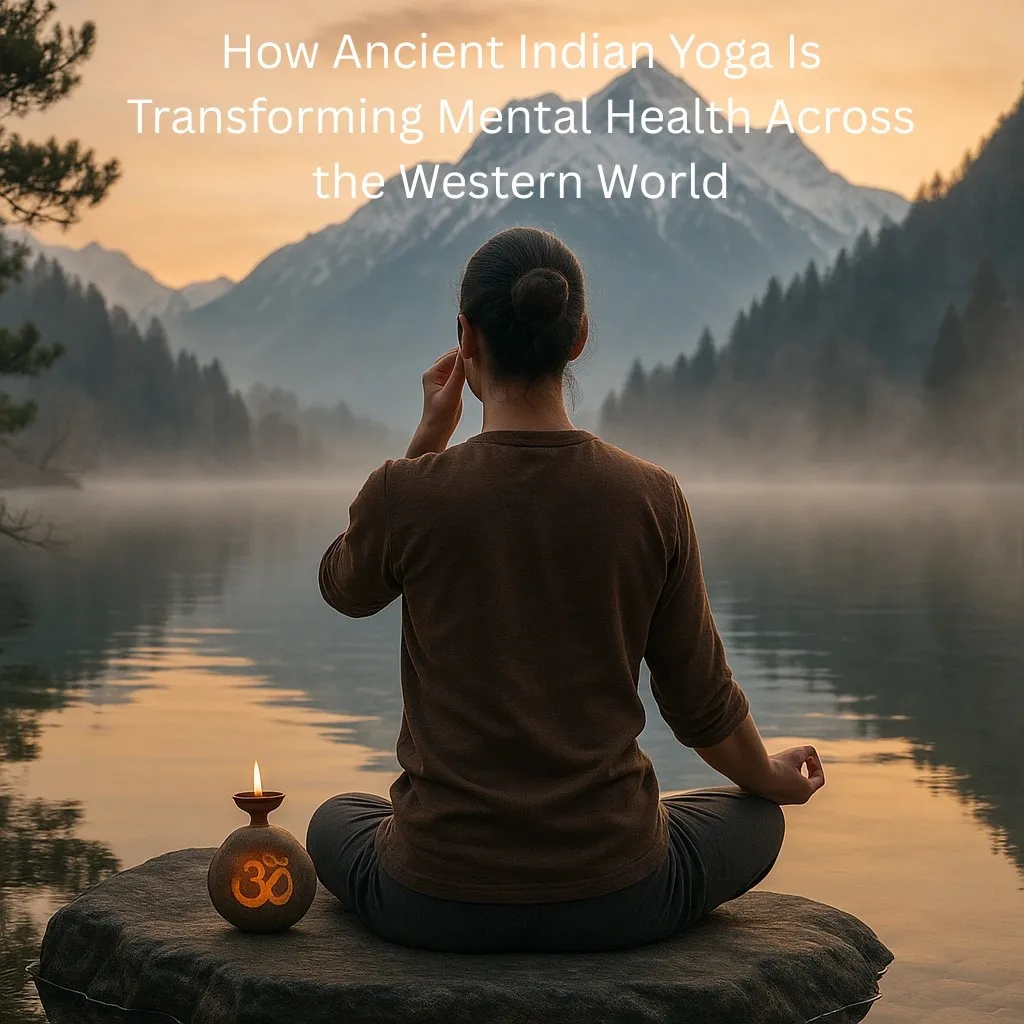Introduction
For centuries, yoga was revered in India as a holistic discipline — a union of the body, mind, and spirit. Originating over 5,000 years ago, ancient Indian yoga was not merely about physical postures but a complete lifestyle practice involving breath control (pranayama), meditation (dhyana), ethical living, and mindfulness. In the last two decades, however, the Western world has increasingly turned to this ancient wisdom, recognizing yoga’s profound role in managing modern mental health challenges.

From the bustling cities of the United States to tranquil retreats in Europe and the United Kingdom, yoga has emerged as an essential tool to combat anxiety, depression, PTSD, and burnout. This article explores how ancient Indian yoga is revolutionizing mental health care in the West and what lessons the world can draw from its timeless healing practices.
1️⃣ Yoga as a Natural Remedy for Anxiety and Depression
In the West, where antidepressants and anti-anxiety medications are commonly prescribed, many individuals are seeking natural, side-effect-free alternatives. Yoga has emerged as one of the most effective solutions. Practices like pranayama (controlled breathing) and dhyana (meditation) help calm the nervous system, reduce cortisol levels, and foster emotional balance.
Studies conducted in the US and UK suggest that regular yoga sessions significantly reduce symptoms of generalized anxiety disorder and clinical depression. Gentle asanas paired with mindful breathing anchor individuals in the present moment, breaking the cycle of racing thoughts and constant worry.
Teaching for World:
In an age dominated by stress and mental fatigue, adopting ancient yoga techniques can offer societies a holistic, accessible tool for improving emotional health without dependence on pharmaceuticals.
2️⃣ Yoga’s Role in Trauma Recovery and PTSD Treatment
Post-Traumatic Stress Disorder (PTSD) is a severe mental health condition affecting millions, particularly war veterans, abuse survivors, and those exposed to natural disasters. Western therapists have increasingly integrated yoga as part of trauma recovery programs.
Specific yoga styles like restorative yoga, trauma-sensitive yoga, and hatha yoga focus on gentle movements, deep breathing, and mindfulness, helping patients regain control over their bodies and emotions. Yoga facilitates emotional release and fosters a sense of inner safety, which is vital for PTSD recovery.
Teaching for World:
Integrating traditional yoga with modern trauma therapy can provide a compassionate, effective healing model for emotionally distressed individuals worldwide.
3️⃣ Yoga for Managing Workplace Stress and Burnout
With rising workplace demands, tight deadlines, and the blurred line between personal and professional life in the digital age, stress-induced burnout has become a silent crisis in Western countries. Corporates in the US and Europe are increasingly turning to yoga sessions as part of employee wellness programs.
Practices like chair yoga, mindfulness meditation during breaks, and end-of-day relaxation sessions are helping professionals cope with stress, anxiety, and mental exhaustion. These interventions are not only enhancing productivity but also reducing absenteeism and improving overall job satisfaction.
Teaching for World:
Integrating yoga into professional environments worldwide can foster healthier, happier, and more balanced work cultures, reducing stress-related health issues and boosting organizational productivity.
4️⃣ Yoga and Its Impact on Sleep Disorders
Sleep disorders like insomnia and disrupted sleep cycles have become widespread in Western societies. Yoga has shown remarkable results in improving sleep quality through practices that calm the mind and regulate the nervous system. Techniques like yoga nidra (yogic sleep) and evening restorative yoga sessions prepare the body for restful, uninterrupted sleep.
Multiple studies from universities in the US have confirmed that individuals practicing yoga report deeper, more restorative sleep and a reduction in sleep-related anxiety. Better sleep hygiene directly contributes to better mental health and reduced emotional fatigue.
Teaching for World:
Incorporating ancient yogic practices into daily routines can help people globally manage insomnia and improve their overall mental resilience.
5️⃣ Yoga as a Tool for Emotional Regulation and Mindfulness
One of yoga’s most celebrated benefits in the West has been its ability to teach emotional regulation and mindfulness. Western therapists and psychologists are incorporating yogic breathing techniques and mindfulness meditation to help clients manage overwhelming emotions and cultivate mental clarity.
Techniques such as alternate nostril breathing (Nadi Shodhana) and mindful awareness practices have proven effective in helping individuals respond calmly to stress, anger, and anxiety triggers, promoting emotional stability.
Teaching for World:
Embedding mindfulness practices drawn from yoga traditions can help global communities nurture inner calm, emotional awareness, and a culture of compassion.
Conclusion
Ancient Indian yoga is no longer a mystical Eastern tradition — it has evolved into a global mental health phenomenon. From reducing anxiety and depression to addressing PTSD, workplace stress, and insomnia, yoga’s holistic approach offers a natural, accessible, and scientifically validated path to emotional wellness.
As mental health crises intensify across the world, integrating yoga into modern healthcare, corporate wellness, educational institutions, and community programs can significantly improve emotional well-being and foster a culture of balance and inner peace.
Teaching for World:
By embracing ancient Indian yoga not just as physical exercise but as a complete mental, emotional, and spiritual practice, societies worldwide can address the growing mental health crisis with compassion, wisdom, and holistic care.

Narendra Singh is the founder of this website. He has considerable experience in the hotel industry. Through his articles, he expresses his views to make people aware of the evils going on in the society and to avoid them. To fulfill this objective, he has switched his 18 years long career of the hotel industry and entered in his favorite and interesting career, media. He not only warns against social evils, Rather, by using the Right to Information Act 2005, they expose social evils and inform the concerned department for action against the culprits.
